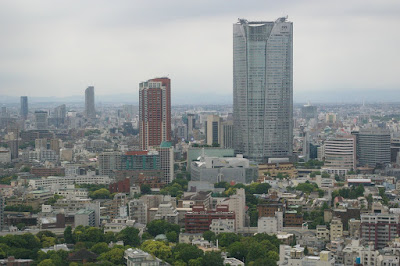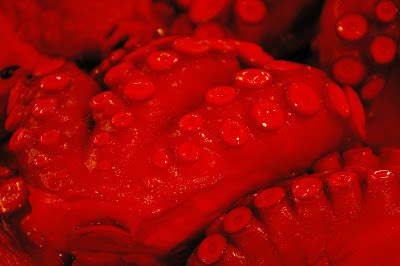
While at Shimbashi, searching for an observation deck, I found myself on the top floors of the Carreta Dentsu Building (Dentsu is the huge advertising agency in Tokyo), where there were several "Restaurants in the Air" serving lunch. I had an amazing five course, traditional Japanese meal, starting with the salad above. If you look closely, you'll see that the white strands, which at first look like shredded radish or cabbage, have eyes.

Then this amazing crab cake and miniature shrimp tempura, with a thick seaweed sauce.

The main course was a sashimi mix, including the roe, above, and the beautiful plate of fish below.

And for desert, this beautiful black-sesame egg custard square, garnished with strawberry, cream, and mint.

The courses came slowly and were all layed out on the same ebony tray, which was (to my great shame) wiped clean after each course as well. It was a slow meal, which was great, as I was looking out over the Sumida River, Tsukiji fish market, the old detached Imperial Gardens, and Odaiba. The presentation seemed focused on angles and curves, accentuation of the food's colors, and a sequence of textures (rice and fish served from wood, roe and custard served from porcelain, soy soup served in metal, salad in earthenware)
 This year, in returning to the Tokyo Tower, we asked our students to think less about the view--amazing as it is--than about the "Tower experience," which is integrated in a series of Tokyo Tower products, two official mascots, costumes for the workers, and four or five layers of shops and activities as one exits the tower. What trip could be complete, for example, without a special pork sandwich, made especially for the Tower?
This year, in returning to the Tokyo Tower, we asked our students to think less about the view--amazing as it is--than about the "Tower experience," which is integrated in a series of Tokyo Tower products, two official mascots, costumes for the workers, and four or five layers of shops and activities as one exits the tower. What trip could be complete, for example, without a special pork sandwich, made especially for the Tower? We did want them to think about how the Tower is used to orient one's sense of urban space though. The tower, which is almost a duplicate of the Eiffel Tower, was built in the 1950s as a crucial monument to Japan's reintegration into the global community...and to show that Japan could do the same things as European countries, perhaps a bit better. (The Tower is therefore 8 meters taller than the Eiffel Tower.)
We did want them to think about how the Tower is used to orient one's sense of urban space though. The tower, which is almost a duplicate of the Eiffel Tower, was built in the 1950s as a crucial monument to Japan's reintegration into the global community...and to show that Japan could do the same things as European countries, perhaps a bit better. (The Tower is therefore 8 meters taller than the Eiffel Tower.)  Despite the imitation of its French counterpart, the Tokyo Tower doesn't work in the same way, partly because there are no building ordinances keeping other buildings smaller. This is really apparent looking at the Tower from the mid-level observation deck of Roppongi's Moti Building, from which the TT looks almost like a small toy. By contrast, the Roppongi highrise (two pictures above), viewed from the TT, looks like a counterpart to the Tower, maybe as tall, but not significantly bigger. It's this odd kind of optical illusion--that makes where one is seem like a center, compared to where one isn't--that helps one locate oneself in the city.
Despite the imitation of its French counterpart, the Tokyo Tower doesn't work in the same way, partly because there are no building ordinances keeping other buildings smaller. This is really apparent looking at the Tower from the mid-level observation deck of Roppongi's Moti Building, from which the TT looks almost like a small toy. By contrast, the Roppongi highrise (two pictures above), viewed from the TT, looks like a counterpart to the Tower, maybe as tall, but not significantly bigger. It's this odd kind of optical illusion--that makes where one is seem like a center, compared to where one isn't--that helps one locate oneself in the city. There is also the odd phenomenon of feeling like one is in a separate city in the sky, which is most concretely experienced in the transparent floor windows. The little girl above was not fazed by this at all, but I found the downward line of sight disorienting.
There is also the odd phenomenon of feeling like one is in a separate city in the sky, which is most concretely experienced in the transparent floor windows. The little girl above was not fazed by this at all, but I found the downward line of sight disorienting.



















